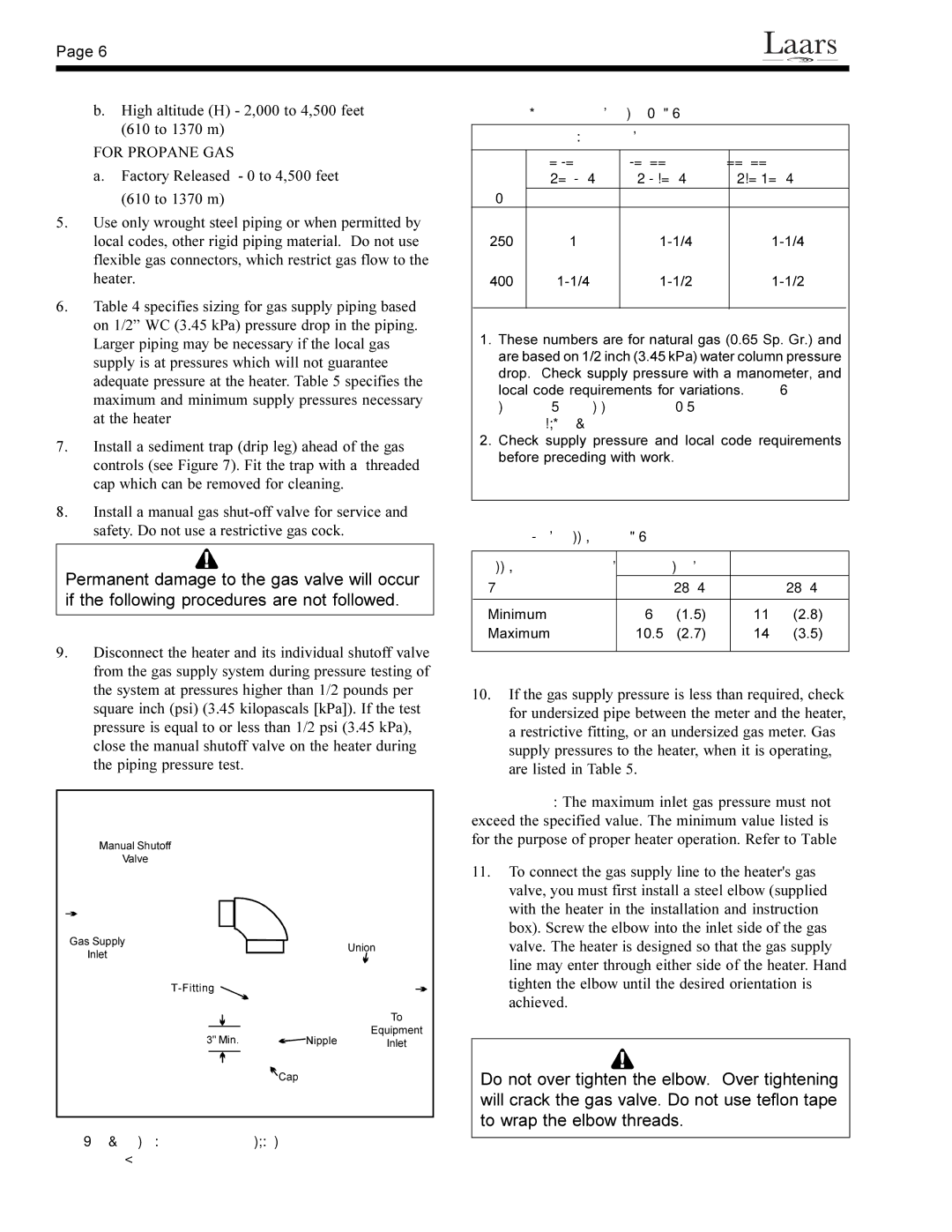
Page 6
b.High altitude (H) - 2,000 to 4,500 feet (610 to 1370 m)
FOR PROPANE GAS
a.Factory Released - 0 to 4,500 feet (610 to 1370 m)
5.Use only wrought steel piping or when permitted by local codes, other rigid piping material. Do not use flexible gas connectors, which restrict gas flow to the heater.
6.Table 4 specifies sizing for gas supply piping based on 1/2” WC (3.45 kPa) pressure drop in the piping. Larger piping may be necessary if the local gas supply is at pressures which will not guarantee adequate pressure at the heater. Table 5 specifies the maximum and minimum supply pressures necessary at the heater when it is operating.
7.Install a sediment trap (drip leg) ahead of the gas controls (see Figure 7). Fit the trap with a threaded cap which can be removed for cleaning.
8.Install a manual gas
CAUTION
Permanent damage to the gas valve will occur if the following procedures are not followed.
9.Disconnect the heater and its individual shutoff valve from the gas supply system during pressure testing of the system at pressures higher than 1/2 pounds per square inch (psi) (3.45 kilopascals [kPa]). If the test pressure is equal to or less than 1/2 psi (3.45 kPa), close the manual shutoff valve on the heater during the piping pressure test.
Manual Shutoff
Valve
Gas Supply |
| Union |
Inlet |
| |
|
| |
|
| |
|
| To |
3" Min. | Nipple | Equipment |
Inlet | ||
| Cap |
|
Figure 7. The Proper Design for a Sediment Trap/Drip Leg.
Table 4. Natural Gas Pipe Size Requirements
Distance from Gas Meter
|
| |||
Heater |
|
|
| |
Size | in. | in. | in. | |
250 | 1 |
| ||
400 |
| |||
|
|
|
|
|
Notes:
1.These numbers are for natural gas (0.65 Sp. Gr.) and are based on 1/2 inch (3.45 kPa) water column pressure drop. Check supply pressure with a manometer, and local code requirements for variations. For liquefied petroleum gas, reduce pipe diameter one size, but maintain a 3/4 inch minimum diameter.
2.Check supply pressure and local code requirements before preceding with work.
Table 5. Gas Supply Pressure Requirements
Supply Pressure | Natural Gas | Propane Gas | ||
Water Column | in. | (kPa) | in. | (kPa) |
|
|
|
|
|
Minimum | 6 | (1.5) | 11 | (2.8) |
Maximum | 10.5 | (2.7) | 14 | (3.5) |
|
|
|
|
|
10.If the gas supply pressure is less than required, check for undersized pipe between the meter and the heater, a restrictive fitting, or an undersized gas meter. Gas supply pressures to the heater, when it is operating, are listed in Table 5.
NOTE: The maximum inlet gas pressure must not exceed the specified value. The minimum value listed is for the purpose of proper heater operation. Refer to Table
11.To connect the gas supply line to the heater's gas valve, you must first install a steel elbow (supplied with the heater in the installation and instruction box). Screw the elbow into the inlet side of the gas valve. The heater is designed so that the gas supply line may enter through either side of the heater. Hand tighten the elbow until the desired orientation is achieved.
![]() CAUTION
CAUTION
Do not over tighten the elbow. Over tightening will crack the gas valve. Do not use teflon tape to wrap the elbow threads.
